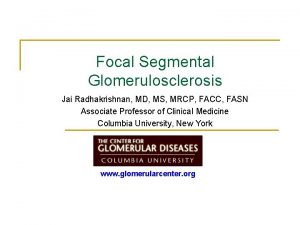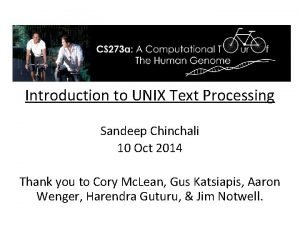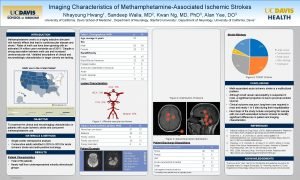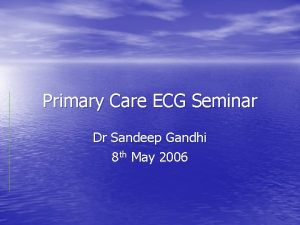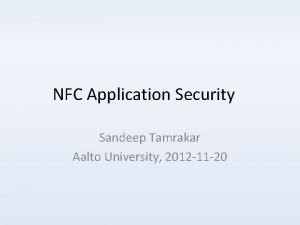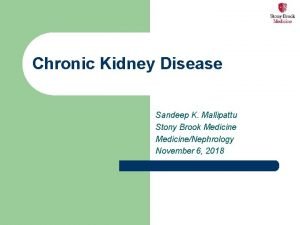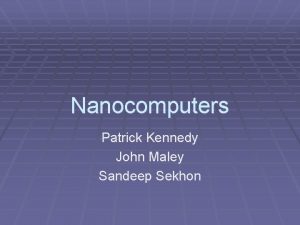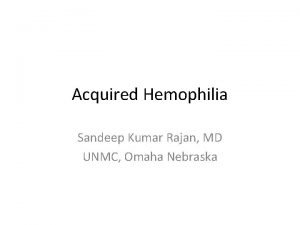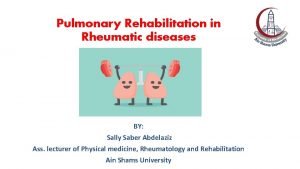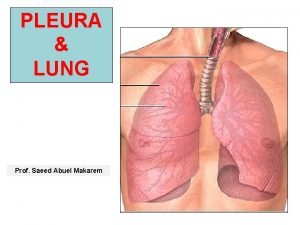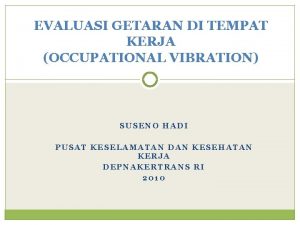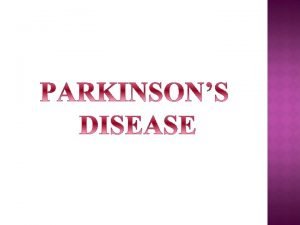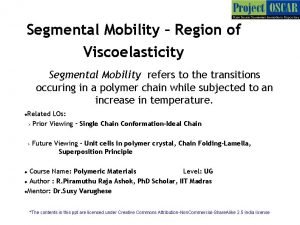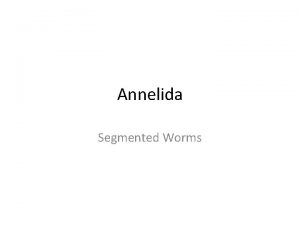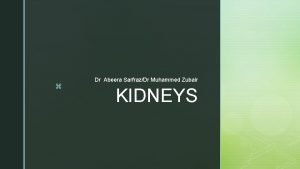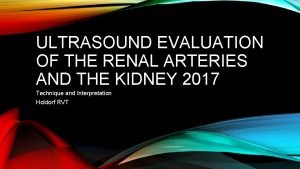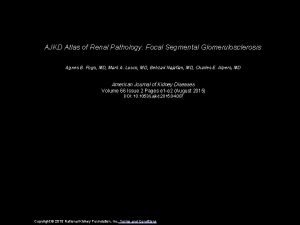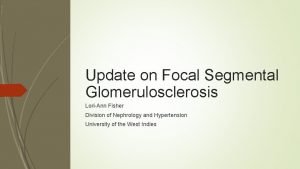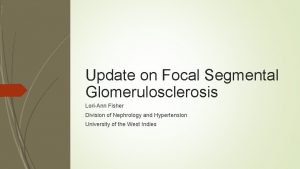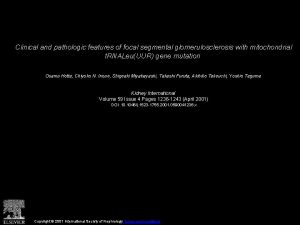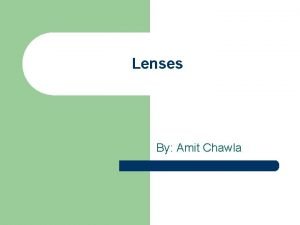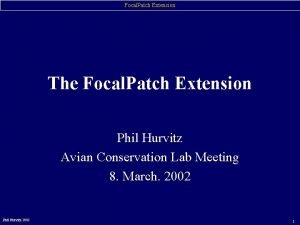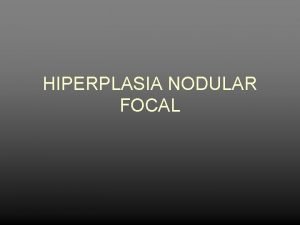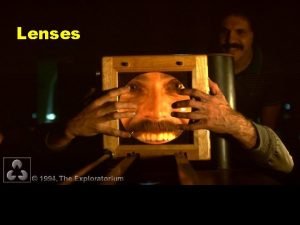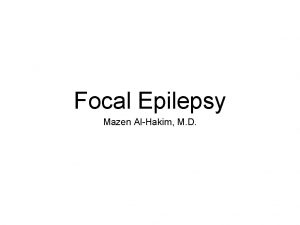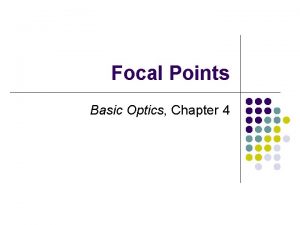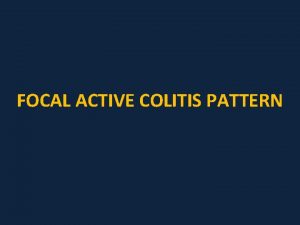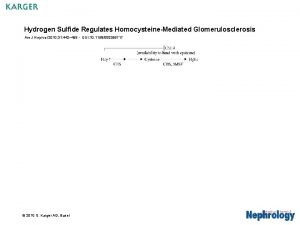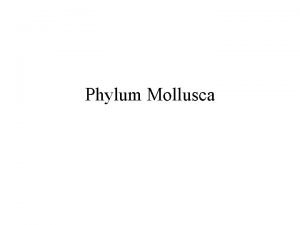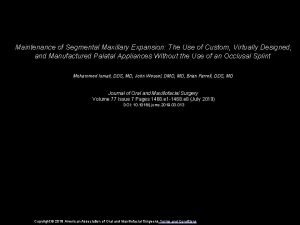Focal Segmental Glomerulosclerosis Sandeep G Huilgol Introduction 20

































- Slides: 33

Focal Segmental Glomerulosclerosis Sandeep G Huilgol

Introduction • 20% of cases in Children and 40% cses in Adults • Progressive glomerular scarring early in the disease course • Glomerulosclerosis is both focal, involving a minority of glomeruli, and segmental, affecting a portion of the glomerular globe.

• It is typically characterized by Proteinuria, accompanied by hypoalbuminemia, hypercholesterolemia, and peripheral edema – i. e. Nephrotic Syndrome. • Approximately 75 to 90% of children and 50 to 60% of adults with focal segmental glomerulosclerosis have the nephrotic syndrome at presentation.

• Now considered a part of a complex of disorders – PODOCYTOPATHIES. • Podocyte injury leads to effacement of the podocyte foot processes. • Change in podocyte shape occurs due to rearrangement of the actin cytoskeleton • E. g. Minimal Change disease and FSGS.




Mechanisms of Disease Podocyte cell changes ↓ Perturbation of podocyte attachment to GBM (α 3β 1 integrin, dystroglycan, podoplanin) ↓ GBM denudation and collapse of capillary loops ↓ Deposition of hyaline material, adherence to Bowman’s capsule and formation of synechiae ↓ Sclerosis (GBM-like material)

Podocyte injury Causes of podocyte injury • Immunologic circulating factors (recurrence of FSGS after Tx) • Genetic mutations (nephrin, podocin, α-actinin-4, WT 1) • Hyperfiltration / stretch (remnant kidney, obesity, reflux) • Ischemia (ageing, hypertensive nephrosclerosis) • Viral infection (HIV, Parvovirus B 19, Simian virus 40) • Toxic agents (heroin, pamidronate)

• The normal glomerular capillaries are widely patent and have intact foot processes (or pedicels) along their outer aspect. • Podocytes that are targeted by cellular stresses, such as permeability factors (external causes) or disease causing mutations (intrinsic defects), respond by the reorganization of their actin cytoskeleton, leading to foot-process effacement. • This change in cell shape forms a sheet of undifferentiated cytoplasm over the surface of the glomerular basement membrane.

• If the inciting injurious factors are long-standing or the podocyte is exposed to second hits, a critical level of cell stress is reached and the injured or dying podocyte detaches from the glomerular basement membrane. • Because podocytes are unable to repair by cell division, attrition of a finite number of podocytes leads to sclerosis of the underlying glomerular capillaries, which become obliterated by matrix. • At these sites, adhesions to Bowman’s capsule may form, and parietal cells often migrate onto the tuft, where they lay down loose matrix material. • In the early stages, the sclerotic lesions are typically segmental, involving a portion of the glomerular tuft.

Indirect evidences of immunological basis • Ability to modulate proteinuria by immunoadsorption • Potential disease recurrence minutes after renal transplantation. • Therapeutic reduction in proteinuria by plasmapheresis. • Serum samples from patients with focal segmental glomerulosclerosis cause increased permeability to albumin in isolated glomeruli and induce foot-process effacement and proteinuria when injected into rats.

Suspected plasma factors: • Cardiotrophin-like cytokine 1, a member of the interleukin-6 family, has permeability activity in a plasma fraction with a molecular weight of less than 30 k. D • Elevated serum levels of soluble urokinase receptor (>3000 pg per milliliter) have been identified in up to two thirds of patients with primary focal segmental glomerulosclerosis but not in those with minimal change disease.

• Increased serum levels of soluble urokinase receptor before renaltx- associated with an increased risk of recurrent disease in the allograft. • Circulating soluble urokinase receptor induces footprocess effacement through the activation of podocyte β 3 integrin, and its effect can be blocked in animal models by neutralizing antibodies targeting soluble urokinase receptor. • The cellular source and stimulants of soluble urokinase receptor in patients with focal segmental glomerulosclerosis are unknown.

Viral infections • Viruses can act on the podocyte either by direct infection or by the release of inflammatory cytokines that interact with podocyte receptors. • The best studied - human immunodeficiency virus type 1 (HIV-1), which directly infects podocytes and tubular epithelial cells. • Evidence supports HIV-1 entry by transfer from infected T cells to tubular epithelial cells through virologic synapses formed during cell adhesion, independent of CD 4. • HIV-1 can persist in the kidney epithelium despite antiretroviral therapy and normalization of peripheral CD 4 counts. • HIV-1 gene expression by infected renal epithelium in turn induces dysregulation of host genes.

• In vivo and in vitro models have identified viral genes nef and vpr as particularly important in HIVAN pathogenesis. • Nef, a virulence factor, contains a proline-rich motif that interacts with the SH 3 domain of the Src family kinases. • Parvovirus B 19 is another virus that can infect podocytes and tubular cells, leading to collapsing focal segmental glomerulosclerosis. • Other viruses associated with this disease, such as simian virus 40, cytomegalovirus, and Epstein–Barr virus, are less well characterized.

Adaptive FSGS • Maladaptive responses may arise through a reduction in the number of functioning nephrons or through mechanisms that place hemodynamic stress on an initially normal nephron population (e. g. , in morbid obesity, cyanotic congenital heart disease, and sickle cell anemia) • Biopsy samples obtained from such patients often show enlarged glomeruli, perihilar sclerosis, and relatively mild degrees of foot-process effacement.

• Reflex vasodilatation of both the afferent and efferent arterioles follows a marked reduction in renal mass, causing elevation in the flow rate in the glomerular capillaries. • Because the reduction in vascular resistance is greater in the afferent arteriole than in the efferent arteriole, glomerular hydrostatic pressure rises, producing glomerular hypertension. • These responses cause an elevation in the single-nephron glomerular filtration rate. • Glomerular volume and surface area increase, placing mechanical strain on podocytes that stretch to cover the expanding tuft. • Some hypertrophied podocytes detach, producing denuded patches of glomerular basement membrane. • These sites become covered by parietal cells, leading to the formation of a synechia to Bowman’s capsule and a nidus for the development of segmental sclerosis.

• Although this scenario is the initiating step in the adaptive forms of focal segmental glomerulosclerosis, it may supervene in the later stages of other forms of the disease. • The loss of a critical number of nephrons promotes the activation of (RAS), exacerbating proteinuria and setting the stage for progressive glomerulosclerosis regardless of the initial cause. • Angiotensin II also has direct proapoptotic effects on podocytes. • Excessive protein uptake by podocytes induces podocyte TGFβ, which promotes apoptosis and leads to endoplasmic reticulum stress, cytoskeletal reorganization, and dedifferentiation.

• Drugs that are aimed at the inhibition of RAS (such as angiotensin-converting– enzyme [ACE] inhibitors and angiotensinreceptor blockers) lower intraglomerular filtration pressures through the inhibition of angiotensin II–mediated vasoconstriction of the efferent arteriole. • ACE inhibition also augments bradykinin, which contributes to efferent arteriolar dilatation. • The resulting reduction in proteinuria exerts a protective effect on podocytes and tubular cells

Primary : Idiopathic • Genetic disorders – Slit diaphragm proteins: NPHS 1, NPHS 2, CD 2 AP – Cell membrane–associated proteins: TRPC 6, PTPRO, – LAMB 2, ITGB 4, CD 151, ITGA 3 – Cytosolic or cytoskeletal proteins: ACTN 4, PLCE 1, – MYH 9, INF 2, MYO 1 E, ARHGAP 24 – Nuclear proteins: WT 1, SMARCAL 1 – Mitochondrial components: mt. DNA-A 3242 G, COQ 2, – COQ 6 – Lysosomal protein: SCARB 2 • Circulating pathogenic factor(s)

Secondary • Virus-associated: HIV, parvovirus B 19 • Medication-associated: interferon , , or , lithium, bisphonates, anabolic steroids • Adaptation to reduced kidney mass: oligomeganephronia, unilateral kidney agenesis, kidney dysplasia, cortical necrosis, reflux nephropathy, surgical kidney ablation, chronic allograft nephropathy, advanced chronic kidney disease with reduced functioning nephrons, sickle cell anemia • Initially normal kidney mass: diabetes, hypertension, obesity, cyanotic congenital heart disease • Nonspecific pattern of FSGS caused by kidney scarring in glomerular disease

Pathological Classification- (Columbia)




Treatment - KDIGO • Corticosteroid and immunosuppressive therapy be considered only in idiopathic FSGS associated with clinical features of the nephrotic syndrome. • Prednisone be given at a daily single dose of 1 mg/kg (maximum 80 mg) oralternate-day dose of 2 mg/kg (maximum 120 mg). • Initial high dose of corticosteroids be given for a minimum of 4 weeks; continue high-dose corticosteroids up to a maximum of 16 weeks, as tolerated, or until complete remission has been achieved, whichever is earlier.

• Corticosteroids be tapered slowly over a period of 6 months after achieving complete remission. • CNIs be considered as first-line therapy for patients with relative contraindications or intolerance to high-dose corticosteroids (e. g. , uncontrolled diabetes, psychiatric conditions, severe osteoporosis).

Therapy for SR FSGS • Cyclosporine: 3– 5 mg/kg/d: in two divided doses (initial target levels 12 5 to 175 ng/ml ; in case of a remission continue treatment for 1 year then try to slowly taper cyclosporine: reduce cyclosporine dose by 25% every 2 months. • If no remission by 6 months, discontinue cyclosporine treatment. Or • Tacrolimus: 0. 1– 0. 2 mg/kg/d in two divided doses (initial target levels 5– 10 ng/ml And • Prednisone: 0. 15 mg/kg/d for 4– 6 months, then taper off over 4– 8 weeks.




THANK YOU
 Jai radhakrishnan
Jai radhakrishnan Sandeep singh jolly
Sandeep singh jolly Sandeep bhattaram
Sandeep bhattaram Sandeep somaiya
Sandeep somaiya Sandeep chinchali
Sandeep chinchali Sandeep walia md
Sandeep walia md Sandeep sahany
Sandeep sahany Sandeep agarwal aditya birla
Sandeep agarwal aditya birla Dean deakin
Dean deakin Sick sinus syndrome ecg criteria
Sick sinus syndrome ecg criteria Nfc tag type
Nfc tag type Brook
Brook Gampa sandeep
Gampa sandeep Dr sandeep sekhon
Dr sandeep sekhon Sandeep modhvadia
Sandeep modhvadia Sandeep modhvadia
Sandeep modhvadia Sandeep baruah
Sandeep baruah Sandeep rajan md
Sandeep rajan md Shell and tube
Shell and tube Heterochthonous muscles
Heterochthonous muscles Dyspnea scale
Dyspnea scale Segmental bronchus
Segmental bronchus Non segmental phonology
Non segmental phonology Liver physiology and anatomy
Liver physiology and anatomy Juncture examples
Juncture examples Segmental vibration
Segmental vibration Segmental breathing
Segmental breathing Segmental bridge construction ppt
Segmental bridge construction ppt Segmental mobility
Segmental mobility Patinig at mala-patinig sa iisang pantig.
Patinig at mala-patinig sa iisang pantig. Metamerism and tagmatization slideshare
Metamerism and tagmatization slideshare Segmental artery
Segmental artery Polyarteritis nodosa
Polyarteritis nodosa Segmental artery
Segmental artery
